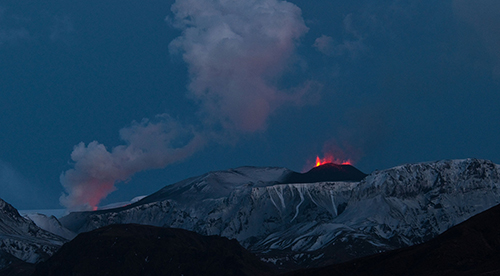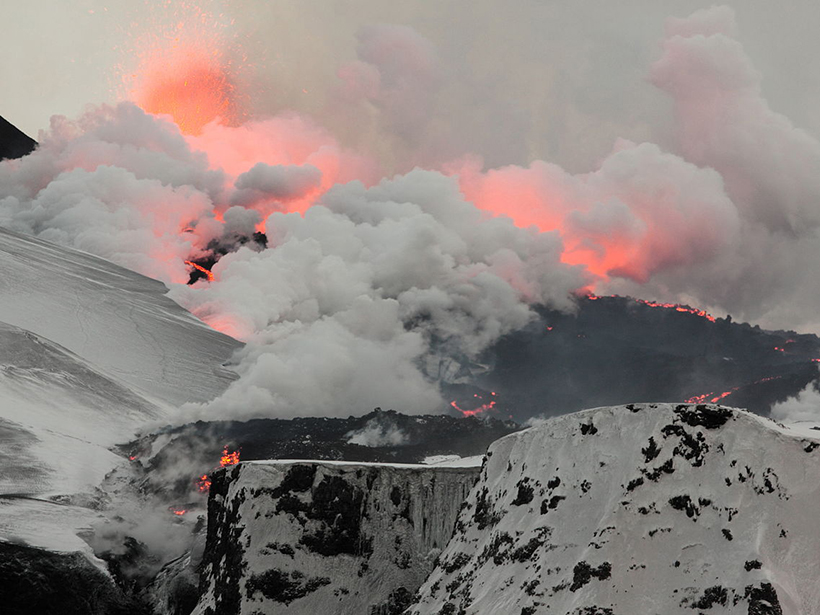When the Eyjafjallajökull volcano in Iceland erupted in 2010, clouds of ash led to massive delays for airlines across Europe. On the slopes of the volcano, other plumes were rising as well: Billowing white steam rose from holes in the glacier as lava flowed underneath and melted the ice from below.
“This was the first eruption where we could document, in a lot of detail, what happens as the lava flow is moving under ice for a pretty good distance.”
For scientists eager to better understand the interplay between lava and glaciers as well as the deadly hazards such interactions can cause, the eruption provided a unique opportunity to gather data and insights.
“This was the first eruption where we could document, in a lot of detail, what happens as the lava flow is moving under ice for a pretty good distance,” said Benjamin Edwards, a volcanologist at Dickinson College in Carlisle, Pa., and coauthor of a new paper published online on 8 June 2016 in the July Bulletin of Volcanology. The findings by Edwards and his colleagues could shed light on past under-ice volcanic eruptions and future dangers from the meltwater floods they cause, Edwards added.
Ice Increases Hazards
Ice-covered volcanoes can produce more hazards than their ice-free cousins. When the heat from lava rapidly melts ice at the top of a mountain, torrents of meltwater can cascade below, overwhelming glacial lakes and causing extensive flooding downstream.

During the 2010 Eyjafjallajökull eruption, for instance, the threat of floods forced the evacuation of around 800 people downstream of the glacier. Nobody died, but part of the ring road that runs along the island’s coast was washed out.
In addition, when moving meltwater mixes with mud and ash, the flowing slurry (called a lahar) can pose extreme dangers. Like torrents of volcanic “concrete,” lahars can cover and entomb people and houses. Notable examples include lahars from the 1991 Mount Pinatubo eruption in the Philippines, during which such flows destroyed thousands of homes, and a 1985 eruption of Nevado Del Ruiz in Colombia, in which lahars contributed to a death toll of around 23,000 people.
A Research Opportunity
In the new paper, the research team describes how they tracked the eruption using aircraft, satellite images, and other data-gathering means. “Iceland is so well prepared for eruptions that as soon as something kicked in, they had all kinds of measurements [from seismometers, webcams, and other instruments] that monitored the eruption,” Edwards explained. The scientists then constructed a timeline of the eruption and mapped the lava’s eventual path.
In addition, a year after the eruption, when it was safer, the team went out to the glacier to examine the lava flows and their impacts on the glacier. The team was initially worried that carbon dioxide levels would be too high—but it was good that they got there when they did, Edwards said. The team was able to observe mostly intact tunnels and arches of ice carved by lava before ice closed them in again.
Evaluating Hazards
Through their analysis, the team learned that the risk from meltwater was greatest during the initial explosive phase of the eruption, when vast amounts of ice melted, triggering torrential bursts. These sudden releases could overflow glacial lakes below, causing severe floods called jökulhlaups, which the authors called “one of the largest hazards associated with volcanic eruptions in Iceland.”
Later, when the lava began to move beneath the glacier, the flow of lava mixed with water carved channels under the ice, localizing and limiting potential dangers and allowing meltwater to escape more regularly.
Clues in Pillow Lavas
Other observations by the team revealed how ice can quench and cool lava, which affects the shape and flow of molten material. These insights should help volcanologists more accurately envision the circumstances of past eruptions under ice, according to the study authors.
When lava interacts with ice, it solidifies into different forms, such as pillow lava. The ice cools the skin of the lava rapidly, creating a glassy, smooth exterior. The still-molten interior pushes through this skin and itself rapidly cools, forming distinctive bulbous lumps.
The risk from meltwater was greatest during the initial explosive phase of the eruption, when vast amounts of ice melted, triggering torrential bursts.
The resulting shapes serve as vital tools for geophysicists who study ancient glaciers. The locations where the pillow lava gives way to other lava forms along the slopes of a volcano give scientists an indication of how far glaciers extended at the time of past eruptions.
Other aspects of ice-influenced lava can tell researchers about the temperature and characteristics of the lava as it emerged. For instance, as opposed to relatively smooth contours of hardened Eyjafjallajökull lava that had penetrated the ice, the roughly 10% that flowed on top of the glacier or beside it formed fields of sharp, jagged `a`a lava, according to the study.
“For someone like me, who looks more at the prehistorical geological record, it’s really important to have these…real-time observations of lava-ice interactions,” said Chris Conway, a volcanologist at Victoria University of Wellington in New Zealand, who was not involved with the study. Researchers can read layers of lava from multiple eruptions to learn how glacial shapes changed over time, he noted.
Although further snowfall can rebuild a glacier diminished by lava, remnants of the path that the molten rock carved through the ice on Eyjafjallajökull remained visible a couple of years ago, when the study authors last returned to the site, Edwards said. Monitoring the remains of ice after an eruption is important because it may help researchers studying ancient volcanoes better understand the changes to lava deposits that were later eroded by reformed glaciers, he explained. Some of the upper portions of the formerly 7.5-kilometer-long glacier at Eyjafjallajökull had filled back in by 2012, Edwards said. However, for the foreseeable future, the glacier will likely remain a kilometer or more shorter than it used to be.
—Elizabeth Deatrick, Editorial Intern; email: [email protected]
Citation:
Deatrick, E. (2016), Eyjafjallajökull gave lava and ice researchers an eyeful, Eos, 97, https://doi.org/10.1029/2016EO055113. Published on 28 June 2016.
Text © 2016. The authors. CC BY-NC-ND 3.0
Except where otherwise noted, images are subject to copyright. Any reuse without express permission from the copyright owner is prohibited.

